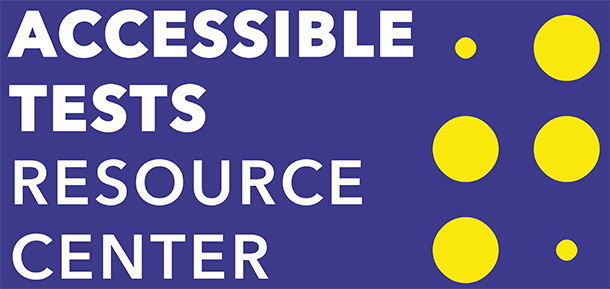Go to navigation for Accessible Tests Resource Center
Laws & Guidelines
Federal legislation mandates that tests should be given in an accessible format. The process for making tests accessible is covered by many guidelines influencing the creation of braille, tactile graphics, image descriptions, large print, online content, and more.
Every Student Succeeds Act (ESSA)
Below are some of the relevant sections from the Notice of Final Regulation: Title I, Part A (opens new window) of title 34 of the Code of Federal Regulations, which impacts assessments for blind and visually impaired students:
Section 200.2(2)(ii): Assessments must “Be developed, to the extent practicable, using the principles of universal design for learning. For the purposes of this section, ‘universal design for learning’ means a scientifically valid framework for guiding educational practice that – (A) Provides flexibility in the ways information is presented, in the ways students respond or demonstrate knowledge and skills, and in the ways students are engaged; and (B) Reduces barriers in instruction, provides appropriate accommodations, supports, and challenges, and maintains high achievement expectations for all students, including students with disabilities and English learners…”
Section 200.6(b)(2): “A State must – (i)(A) Develop appropriate accommodations for students with disabilities; (B) Disseminate information and resources to, at a minimum, LEAs, schools, and parents; and (C) Promote the use of such accommodations to ensure that all students with disabilities are able to participate in academic instruction and assessments… (ii) Ensure that general and special education teachers, paraprofessionals, teachers of English learners, specialized instructional support personnel, and other appropriate staff receive necessary training to administer assessments and know how to administer assessments, including, as necessary, alternate assessments… and know how to make use of appropriate accommodations during assessments for all students with disabilities…”
Section 200.6(b)(3): “A State must ensure that the use of appropriate accommodations…does not deny a student with a disability – (i)The opportunity to participate in the assessment; and (ii) Any of the benefits from participation in the assessment that are afforded to students without disabilities.”
https://www.ed.gov/essa (opens new window)
United States Department of Education
Aside from ESSA, there are other laws which impact the rights of blind and visually impaired students, including the Individuals with Disabilities Education Act (IDEA) and Title II of the Americans with Disabilities Act (ADA). More information on these laws and other education issues can be found at the Department of Education’s website.
https://www2.ed.gov/policy/ (opens new window)
Braille Authority of North America (BANA)
The guiding force for the standardization of braille in North America is BANA, who maintains the guidelines for presenting braille and tactile graphics.
Braille Formats: Principles of Print-to-Braille Transcription, 2016 (opens new window)
Braille Formats: Principles of Print-to-Braille Transcription, 2011 (opens new window)
“Guidance for Transcription Using the Nemeth Code within UEB Contexts” (opens new window)
Guidelines and Standards for Tactile Graphics, 2010 (opens new window)
Nemeth Code for Mathematics & Science Notation (opens new window)
International Council on English Braille (ICEB)
ICEB exists to provide international cooperation among countries using English-language braille, providing the rules for the current braille code used in the U.S., Unified English Braille (UEB).
Rules of Unified English Braille 2013 (opens new window)
Guidelines for Technical Material (opens new window)
Association of Test Publishers (ATP)
Partnering with the International Test Commission, ATP has compiled a thorough document of best practices and issues in the design and administration of technology-based assessments. Section 10 is entirely devoted to Fairness and Accessibility. The content of these guidelines are useful for test developers, test administrators, test takers, and even the public.
Guidelines for Technology-Based Assessments (.pdf, opens new window)
World Wide Web Consortium (W3C)
W3C maintains standards to promote the growth and use of the Web, including many guidelines and examples of how to make websites, including online assessments, accessible.
*These guidelines are beneficial for test developers, programmers, and publishers.
W3C Standards and Guidelines (opens new window)
QTI 3 and Assessments
Question & Test Interoperability® (QTI®) is the standard for designing technology-based assessments. Building upon earlier versions of QTI® and Accessible Portable Item Protocol® (APIP®), the newest version incorporates W3C specifications allowing tests to be designed to support common accommodations used in K-12 assessments in order to be accessible.
General Information: QTI 3 Overview (opens new window)
Technical Information: QTI 3 Specifications (opens new window)
National Center on Accessible Educational Materials (AEM Center)
While the AEM Center is more commonly known for their work involving NIMAS Technical Specifications for materials available in the National Instructional Materials Accessibility Center (NIMAC), they also provide technical assistance on a myriad of accessibility issues. Working with experts from across the United States, the AEM Center has released the following recommendations for State Education Agency (SEA) assessment leaders to ensure timely and equitable assessments are provided for braille readers.
Recommendations for Improving the Provision and Use of Braille for State-Mandated Assessment (opens new window)
National Center for Accessible Media (NCAM)
The Carl and Ruth Shapiro Family National Center for Accessible Media at WGBH (NCAM) makes digital media accessible for people disabilities, including educational media and assessments.
Item Writer Guidelines for Greater Accessibility (opens new window)
Guidelines for Describing Images for Assessments (opens new window)
Northwest Evaluation Association (NWEA)
Working with NCAM, this test publisher has created a set of guidelines for describing images in assessments.
Image Description Style Guide (.pdf, opens new window)
American Printing House for the Blind (APH)
APH has worked with many experts in the field of visual impairment over the years to create additional information about testing blind and visually impaired students.
TEST ACCESS: Making Tests Accessible for Students With Visual Impairments: A Guide for Test Publishers, Test Developers, and State Assessment Personnel, 4th edition by Carol B. Allman, Ph.D., published by the American Printing House for the Blind © APH 2009
Intelligence Testing of Individuals Who Are Blind or Visually Impaired, by Stephen Goodman, Carol Evans, and Marnee Loftin, published by the American Printing House for the Blind © APH 2011
The APH Accessibility Hub provides guidance and best practices for creating accessible documents, meetings, and more.


